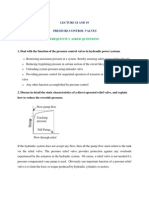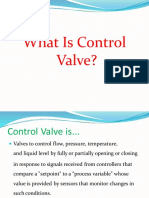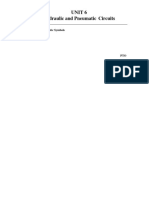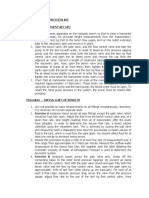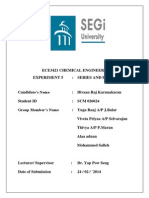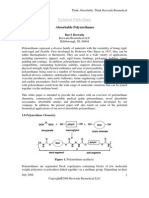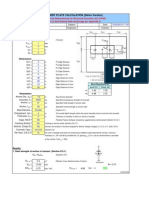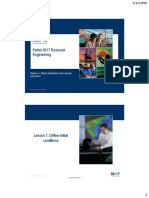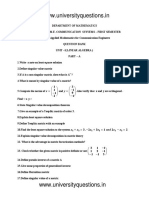ME/ECE 4710 Motion and Control Lab #2: Hydraulic Cylinder Circuits
ME/ECE 4710 Motion and Control Lab #2: Hydraulic Cylinder Circuits
Uploaded by
Vishal PipavatCopyright:
Available Formats
ME/ECE 4710 Motion and Control Lab #2: Hydraulic Cylinder Circuits
ME/ECE 4710 Motion and Control Lab #2: Hydraulic Cylinder Circuits
Uploaded by
Vishal PipavatOriginal Title
Copyright
Available Formats
Share this document
Did you find this document useful?
Is this content inappropriate?
Copyright:
Available Formats
ME/ECE 4710 Motion and Control Lab #2: Hydraulic Cylinder Circuits
ME/ECE 4710 Motion and Control Lab #2: Hydraulic Cylinder Circuits
Uploaded by
Vishal PipavatCopyright:
Available Formats
ME/ECE 4710 Motion and Control Lab #2: Hydraulic Cylinder Circuits
Introduction The purpose of this experiment is to gain some experience using directional control valves and double-acting, single-rod hydraulic cylinders. Two simple circuits are built. The first measures flow from both ends of a cylinder at various pressures. The second is a metering-out circuit used to keep loads from having unwanted acceleration while the cylinder is extending. If a load has uncontrolled acceleration, it is called a runaway load. One example is a heavy load that is being lowered to the ground.
Part 1: Measuring Flow Exiting a Cylinder
Introduction Double-acting, single-rod hydraulic cylinders have different areas and volumes on either side of the piston. As a result, different flow rates and pressures are generated during extension and retraction. In this exercise, you will measure the flow rates of the fluid exiting a cylinder at various supply pressures, calculate the corresponding rod speeds, and explain the results you find. Components 1. Motor and Pump 2. Relief valve 3. Flow meter 4. Pressure gage 5. Solenoid-operated directional control valve 6. Horizontal hydraulic cylinder (1.5 inch diameter bore, 1.0 inch diameter rod) 7. Loose components: hoses Procedure a) Complete steps 1-3 of the Procedure for Connecting a Hydraulic Circuit, setting the relief valve to 100 PSI. b) Complete steps 4-8 of the Procedure for Connecting a Hydraulic Circuit: Connect a hose from a second pressure port on the supply/return manifold to the P port on the solenoid-operated directional control valve. Connect the T port of the directional control valve to the inlet of the flow meter. Connect the outlet of the flow meter to a return port on the supply/return manifold. Connect the A port of the directional control valve to the cap end of the horizontal cylinder. Connect the B port of the directional control valve to the rod end of the horizontal cylinder. c) After the instructor has inspected your circuit, complete steps 9-10 of the Procedure for Connecting a Hydraulic Circuit. Observe and record the flow rates for the cylinder during extension and retraction. Also observe and record how the supply pressure changes during extension and retraction. Increase the supply pressure in 50 PSI increments from 100-300 PSI, observing the flow rates for extension and retraction at each pressure. d) Follow the Shutdown Procedure. After opening the vent valve, sequence the directional control valve from left to right to relieve any built up pressure in the valve body.
1/4
Supply Pressure (PSI) Exit Flow Rate during Extension (LPM or GPM) Exit Flow Rate during Return (LPM or GPM) Change in Supply Pressure (Ext/Ret) (PSI)
100
150
200
250
300
1.50 in. 1.00 in.
Questions 1. How do you explain the trends in the flow rates as you move from 100 to 300 PSI? Which flow rate is larger at each pressure setting? Why? When is the system flow limited? When is it pressure limited? 2. What are the extension and retraction velocities at each pressure? 3. How much flow comes out of the cap end of the cylinder when the cylinder retracts? Is it possible for this flow to be greater than the maximum pump flow? Why? 4. How does the supply pressure change when the cylinder extends? Retracts? Is there any indication that the relief valve is opening during extension or retraction?
0.38 in. 0.38 in.
Pressure at Supply/Return Manifold
0.00 Psi 0.38 in. 0.38 in.
Flow out of Cylinder 0.00 GPM
Vent Valve
0.38 in. 0.38 in.
Pressure Relief
0.00 Psi 0.38 in. 0.38 in.
Pressure Relief Valve Motor Fixed Displacem ent Pump Max. Flow Rate 3 GPM
Part 2: Metering-Out Circuit
Introduction When using a hydraulic cylinder to lower a heavy load, a metering-out circuit is required. In this type of circuit, a restriction is placed on the outflow of the cylinder to control the flow rate, and hence, the velocity of the load. Check valves are used to ensure unrestricted flow in the opposite direction. A metering-out circuit is used whenever the load wants to accelerate in the direction of the motion of the cylinder. Components 1. Motor and Pump 2. Relief valve 3. Flow meter and pressure gage 4. Solenoid-operated directional control valve 5. Flow control valve with built-in check valve 6. Horizontal hydraulic cylinder (1.5 inch diameter bore, 1.0 inch diameter rod) 7. Loose components: hoses
2/4
Procedure a) Complete steps 1-3 of the Procedure for Connecting a Hydraulic Circuit, setting the relief valve to 100 PSI. b) Complete steps 4-8 of the Procedure for Connecting a Hydraulic Circuit: Connect a hose from a second pressure port on the supply/return manifold to the P port on the solenoid-operated directional control valve. Connect the A port of the directional control valve to the cap end of the horizontal cylinder. Place a tee on the rod end of the cylinder. Connect a hose from this tee to the inlet of one of the flow control valves that has a check-valve bypass. From the other branch of the tee, connect a hose to one of the pressure gages. Connect the outlet of the flow control valve to the B port of the directional control valve. Connect the T port of the directional control valve to the inlet of the flow meter. Connect the outlet of the flow meter to a return port on the supply/return manifold. c) After the instructor has inspected your circuit, complete steps 9-10 of the Procedure for Connecting a Hydraulic Circuit. Adjust the flow control valve to provide 3 LPM flow rate at 100 PSI. Using this setting for the flow control valve, complete the table below. d) Follow the Shutdown Procedure. After opening the vent valve, sequence the directional control valve from left to right to relieve any built up pressure. Extension: Max Cylinder Pressure/ Supply Pressure Change (PSI) Retraction: Max Cylinder Pressure/ Supply Pressure Change (PSI)
Supply Pressure (PSI)
Flow Rate Extension
(GPM/LPM)
Flow Rate Retraction
(GPM/LPM)
Time to Extend (sec)
Time to Retract (sec)
100
0.8 / 3
150
200
250
300
3/4
Questions 1. How do your rates of cylinder extension and retraction compare with those you found in Part 1? How can you explain the differences? 2. Is your measured flow rate on extension consistent with your times to extend? How might you explain any differences in these values? 3. Based on your timing data, what are your estimated flow rates during retraction? 4. How do you explain your timing results at various pressures? 5. Is this system ever flow limited? Is it ever pressure limited? 6. What is the maximum pressure on the rod end of the cylinder during extension? How does this pressure compare with the supply pressure? 7. What is the maximum possible pressure on the rod end of the cylinder assuming the flow restrictor is completely closed and the relief valve is set to 300PSI?
1.50 in. 1.00 in.
0.00 Psi
0.38 in. 0.38 in.
0.00 Psi Pressure at Supply/Return Manifold
0.38 in. 0.38 in.
0.00 GPM
0.38 in.
Pressure Relief
0.00 Psi 0.38 in.
Vent Valve
0.38 in.
Pressure Relief Valve Motor Fixed Displacem e nt Pum p Max. Flow Rate 3 GPM
4/4
You might also like
- Lab 6 Structure and Behavior of The DelayDocument15 pagesLab 6 Structure and Behavior of The DelayPard TeekasapNo ratings yet
- Book - English For Physics Students - Vol II PDFDocument9 pagesBook - English For Physics Students - Vol II PDFMariza JuwitaNo ratings yet
- FHSC1134 Lab Manual V4 2-1Document29 pagesFHSC1134 Lab Manual V4 2-1GOUK SY KAI KELVINNo ratings yet
- Fpe PPT OriginalDocument21 pagesFpe PPT OriginalKushal D SNo ratings yet
- Hydraulic and Pneumatic Actuating SystemsDocument10 pagesHydraulic and Pneumatic Actuating SystemsKishanprasad GunaleNo ratings yet
- Hydraulic Lab (7, 8, 9)Document7 pagesHydraulic Lab (7, 8, 9)AbdulmalekNo ratings yet
- Flowmeter DEMONSTRATIONDocument20 pagesFlowmeter DEMONSTRATIONAfiq IkhwanNo ratings yet
- 4.oil Hydraulic Circuit Trainer KitDocument13 pages4.oil Hydraulic Circuit Trainer KitAlmas 1710No ratings yet
- H&P 3unitDocument53 pagesH&P 3unitprabhathNo ratings yet
- CHP 3& 6 Ihp MsdteDocument10 pagesCHP 3& 6 Ihp MsdteRocky JNo ratings yet
- Deal With The Function of The Pressure Control Valves in Hydraulic Power SystemsDocument6 pagesDeal With The Function of The Pressure Control Valves in Hydraulic Power Systems666667100% (1)
- Experiment No 7Document7 pagesExperiment No 7Faizan Ahmed67% (3)
- Lab ManualDocument26 pagesLab ManualHEMANTH KUMAR CNo ratings yet
- Control Valve Characteristics ReportDocument10 pagesControl Valve Characteristics ReportHimanshu JatNo ratings yet
- Control ValveDocument31 pagesControl ValveMohammed AhmedNo ratings yet
- Adjusting The Hydraulic PumpDocument6 pagesAdjusting The Hydraulic PumpSugeng Ciko Darminto90% (10)
- Control Valve ActuatorsDocument31 pagesControl Valve ActuatorsMuhammad ImtiazNo ratings yet
- Lab Manual Sem1 2015 2016-11092015Document26 pagesLab Manual Sem1 2015 2016-11092015Putri SaidatinaNo ratings yet
- Energy Losses in Bends - : Experiment No. - 09Document7 pagesEnergy Losses in Bends - : Experiment No. - 09John Michael Menoza ZapantaNo ratings yet
- Flow ExpDocument5 pagesFlow ExpLawson IdukuNo ratings yet
- Lab 4 (Thermofluids Lab)Document32 pagesLab 4 (Thermofluids Lab)Adnan Nanda0% (1)
- Control Valve (Actuator)Document31 pagesControl Valve (Actuator)Junior7100% (1)
- Automation LabDocument53 pagesAutomation LabMadhusudan BenzNo ratings yet
- Unit 6 Hydraulic and Pneumatic CircuitsDocument49 pagesUnit 6 Hydraulic and Pneumatic CircuitsshubhamrasalNo ratings yet
- Manual Cm-760 - 780 InglesDocument121 pagesManual Cm-760 - 780 InglesULISCHAP100% (1)
- Speed Control ValvesDocument7 pagesSpeed Control Valvesbtme266j2020No ratings yet
- Valves: Iii Year Vi SemDocument69 pagesValves: Iii Year Vi SemKshitij SharmaNo ratings yet
- I. Laboratory Procedure: Procedure (EQUIPMENT SET-UP)Document2 pagesI. Laboratory Procedure: Procedure (EQUIPMENT SET-UP)Chanel AnnNo ratings yet
- Chapter 6 HYDRAULICDocument93 pagesChapter 6 HYDRAULICShishir Gyawali100% (1)
- Unit - 3 Fluid Power SymbolsDocument23 pagesUnit - 3 Fluid Power Symbolsyuvaraja sNo ratings yet
- 20 - Pumps PDFDocument6 pages20 - Pumps PDFEmmanuel EvangelistaNo ratings yet
- Pressure-Control Valves PDFDocument15 pagesPressure-Control Valves PDFRagab Abulmagd100% (1)
- 1.trial On Gear PumpDocument6 pages1.trial On Gear PumpAlmas 1710No ratings yet
- Energy Losses in BendsDocument8 pagesEnergy Losses in BendsVikramSingh0% (3)
- Controlador 4160Document12 pagesControlador 4160Antonio Castillo GNo ratings yet
- Control Valve Characteristics PDFDocument20 pagesControl Valve Characteristics PDFPrem SagarNo ratings yet
- Fluid Flow BenchDocument8 pagesFluid Flow BenchlekhethokhalametsaneNo ratings yet
- CVS 4150 and 4160 Pressure Controllers: Instruction ManualDocument12 pagesCVS 4150 and 4160 Pressure Controllers: Instruction Manualsalmo83:18No ratings yet
- Speed Control Circuit Using MeteringDocument10 pagesSpeed Control Circuit Using MeteringPankaj Gurav0% (1)
- Eaton: Pressure or Pressure-Flow Compensator Control Adjustment ProceduresDocument4 pagesEaton: Pressure or Pressure-Flow Compensator Control Adjustment ProceduresFernando SabinoNo ratings yet
- Hydraulics - 48-111-A New LogoDocument39 pagesHydraulics - 48-111-A New LogoManoj BNo ratings yet
- Control Valve CharacteristicsDocument9 pagesControl Valve CharacteristicsSiddhartha Sharma100% (1)
- ch5 Hydraulic and pneumatic actuatorsDocument36 pagesch5 Hydraulic and pneumatic actuatorsFaizul HassanNo ratings yet
- UNIT II - Hydraulic Valves and AccessoriesDocument73 pagesUNIT II - Hydraulic Valves and Accessoriesgaya.71772115121No ratings yet
- Control Components in Hydraulic SystemDocument68 pagesControl Components in Hydraulic SystemYashwanth Mg100% (1)
- Insdustrial Hydraulics Manual: Volume ControlsDocument19 pagesInsdustrial Hydraulics Manual: Volume ControlsM Ahmed LatifNo ratings yet
- ContentsDocument41 pagesContentsScientist SakthivelNo ratings yet
- AHP NotesDocument26 pagesAHP NotesDr.R.Pugazhenthi Associate Prof.No ratings yet
- Series & Parallel PumpDocument14 pagesSeries & Parallel PumpDivaan Raj Karunakaran100% (3)
- TTC Pneumatic CYLINDER PDFDocument30 pagesTTC Pneumatic CYLINDER PDFwienna1987No ratings yet
- ch5 Hydraulic and Pneumatic Actuators PDFDocument30 pagesch5 Hydraulic and Pneumatic Actuators PDFnguyennguyenNo ratings yet
- 1001-Experimental Evaluation of A Digital Hydraulic Power Management SystemDocument15 pages1001-Experimental Evaluation of A Digital Hydraulic Power Management SystemPhanHathamNo ratings yet
- Losses in Bends FittingsDocument26 pagesLosses in Bends Fittingsdainer08No ratings yet
- Module 3 FPEDocument21 pagesModule 3 FPERakshith GowdaNo ratings yet
- Detailed Notes - All Valves - Pumps - Design CirciutsDocument63 pagesDetailed Notes - All Valves - Pumps - Design CirciutsJimmy KariukiNo ratings yet
- Rtaa SB 4 - 10011991Document6 pagesRtaa SB 4 - 10011991alcomech100% (3)
- Basic HydraulicsDocument17 pagesBasic HydraulicsDennis Roldan SilvaNo ratings yet
- 06 Pressure Control ValvesDocument55 pages06 Pressure Control ValvesZakariya ChoudharyNo ratings yet
- IHP Chap 3Document23 pagesIHP Chap 3md.shoaib9368No ratings yet
- Super Choke BasicsDocument10 pagesSuper Choke Basicsel_guariquenoNo ratings yet
- Types of Valves in Piping: Types of Valves - Tables to estimate man hours of assemblyFrom EverandTypes of Valves in Piping: Types of Valves - Tables to estimate man hours of assemblyNo ratings yet
- Marvel Carbureter and Heat Control As Used on Series 691 Nash Sixes Booklet SFrom EverandMarvel Carbureter and Heat Control As Used on Series 691 Nash Sixes Booklet SNo ratings yet
- Tesla and Edison Compare and Contrast EssayDocument4 pagesTesla and Edison Compare and Contrast Essayapi-459278569No ratings yet
- K1412 SanyoDocument4 pagesK1412 SanyofNo ratings yet
- Nmo QuesDocument12 pagesNmo QuesmaheshnagarkarNo ratings yet
- Section I Antiperspirants and DeodorantsDocument22 pagesSection I Antiperspirants and DeodorantsNERO3000No ratings yet
- Presentation Lesson 22 Vibrations and WavesDocument78 pagesPresentation Lesson 22 Vibrations and WavesFitri Apitrii100% (2)
- ME451: Control Systems Course RoadmapDocument4 pagesME451: Control Systems Course RoadmapVu NghiaNo ratings yet
- Absorb Able PolyurethanesDocument9 pagesAbsorb Able Polyurethanesterminator45No ratings yet
- ANSI Pipe Marking StandardsDocument4 pagesANSI Pipe Marking StandardsRobert Emile Santiago JimenezNo ratings yet
- Study of Reflection of New Low-Reflectivity Quay Wall Caisson PDFDocument11 pagesStudy of Reflection of New Low-Reflectivity Quay Wall Caisson PDFdndudcNo ratings yet
- Embedpl v1-4 Demo PDFDocument5 pagesEmbedpl v1-4 Demo PDFMWKELIOLANo ratings yet
- Weston Fundner - Research Paper 2020Document4 pagesWeston Fundner - Research Paper 2020api-499416081No ratings yet
- 2011 WormholesDocument18 pages2011 WormholesThata Reddy100% (1)
- 1 Understanding DerivativeDocument86 pages1 Understanding DerivativetitoNo ratings yet
- 1987 - Generalized Predictive Control - Part I - Clarke PDFDocument12 pages1987 - Generalized Predictive Control - Part I - Clarke PDFademargcjuniorNo ratings yet
- 604 and 304 Specialty Hydraulic Hose: Catalog 4400 USDocument1 page604 and 304 Specialty Hydraulic Hose: Catalog 4400 USJorge Andres PozoNo ratings yet
- Mass BalancingDocument11 pagesMass BalancingJanine BatacanNo ratings yet
- Petrel RE Workshop (24-25 April 2019)Document42 pagesPetrel RE Workshop (24-25 April 2019)Imam Zulkifli S100% (6)
- TECH VibrationDiagnosticGuideDocument2 pagesTECH VibrationDiagnosticGuidetiagofer84575No ratings yet
- MA7158-Applied Mathematics For Communication Engineers Question BankDocument15 pagesMA7158-Applied Mathematics For Communication Engineers Question BanksharmikbkNo ratings yet
- 38DLPlus Training Power PointDocument236 pages38DLPlus Training Power PointptrabinNo ratings yet
- NTS Paper Patren by Shad BalochDocument10 pagesNTS Paper Patren by Shad BalochShad BalochNo ratings yet
- Magnetism and Electromagnetism by PavanDocument13 pagesMagnetism and Electromagnetism by PavanGopipavanNo ratings yet
- Wireless Power DERIVATION OF AN 'INVERSE LI ENARD-WIECHERT EFFECT' FROM THE LORENTZ FORCE AND ITS APPLICATION TO THE WIRELESS POWER TRANSFERDocument10 pagesWireless Power DERIVATION OF AN 'INVERSE LI ENARD-WIECHERT EFFECT' FROM THE LORENTZ FORCE AND ITS APPLICATION TO THE WIRELESS POWER TRANSFERRobertFBishopNo ratings yet
- Precision and Accuracy in Measurements: The Author RepliesDocument1 pagePrecision and Accuracy in Measurements: The Author RepliesNurani FitriNo ratings yet
- Non-Ideal Reactors: Residence Time Distribution (RTD)Document10 pagesNon-Ideal Reactors: Residence Time Distribution (RTD)BigNo ratings yet
- Unit 3 FEM Bar & Beam Elements PDFDocument14 pagesUnit 3 FEM Bar & Beam Elements PDFHarsh PatelNo ratings yet










